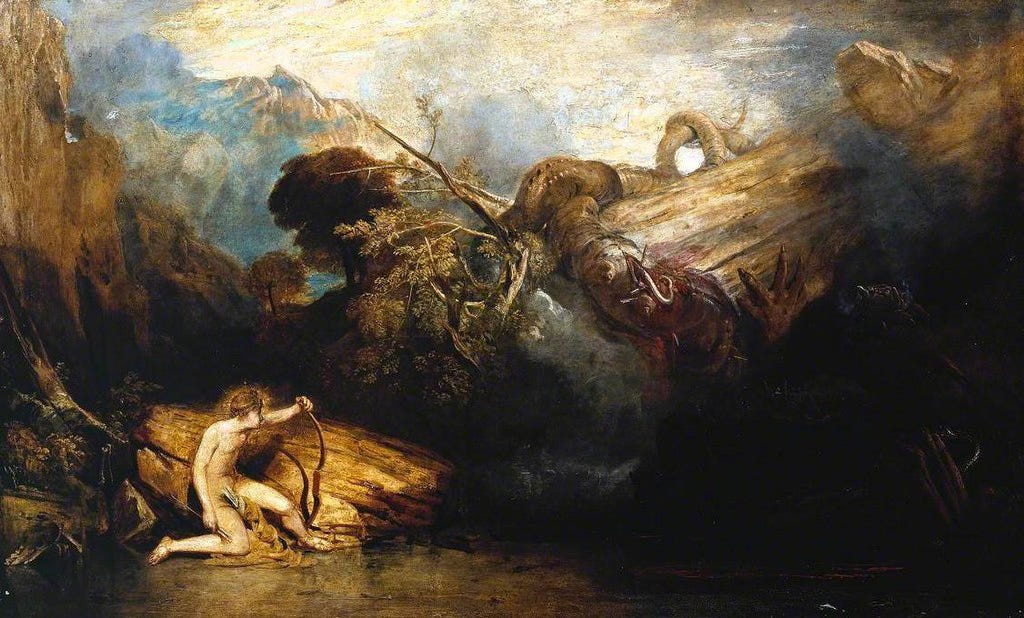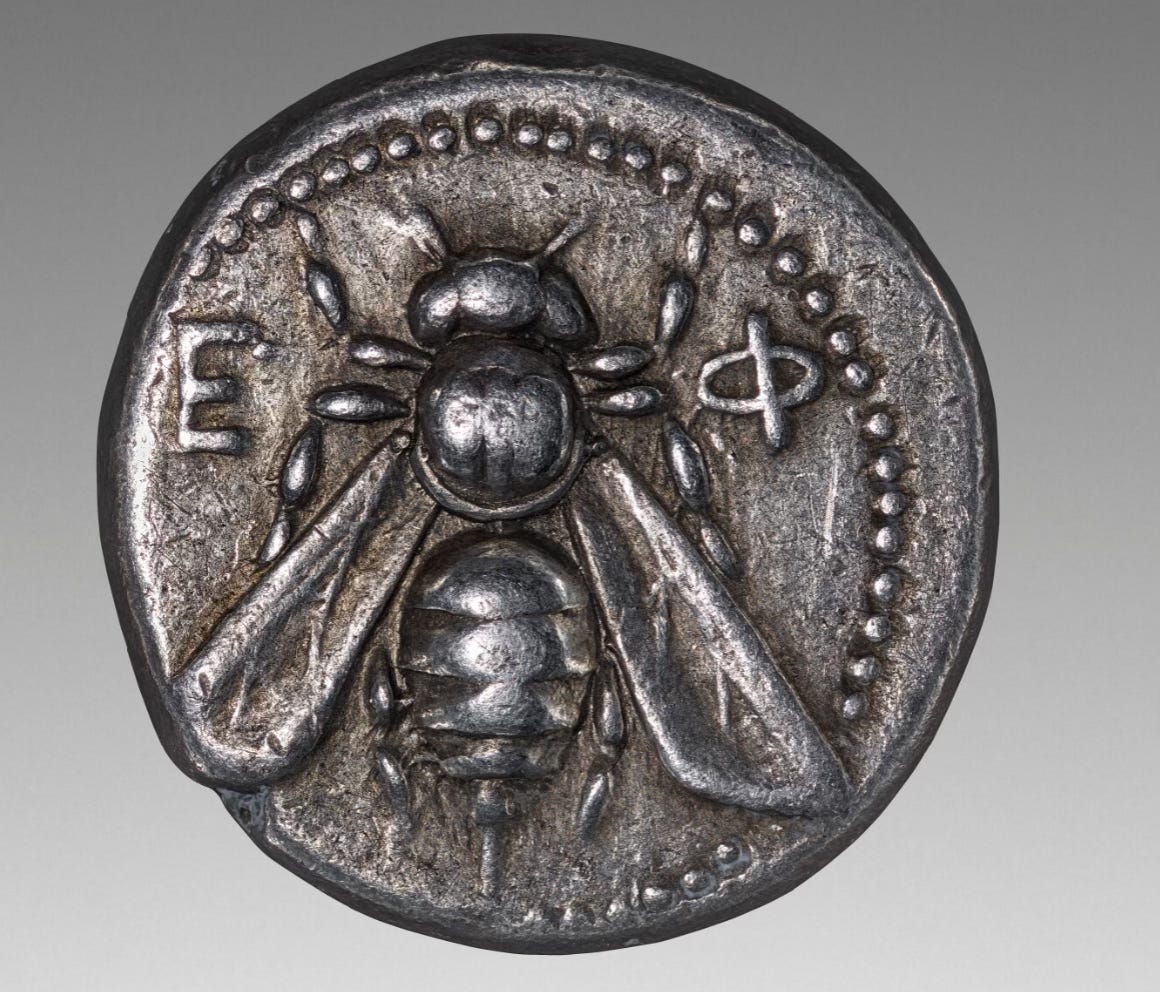
Please listen to my narration above and read “Thieves of the Honey Cave” Part I.
I speak to you first, blessed Corcyian cave, as I sit before your ancient black mouth; your sacred darkness.
You who called–compelled me with convulsions to make offerings, and I have come. My heart trembles at first touch of your great tooth; surprised how swift a gentle weeping comes to me, one who struggles to shed tears. You feel an old friend long thought dead and now returned. Stunned to reverent silence, I crawl down your rain-moist tongue. Awe opens my jaw. How long have you been womb of our ecstasies and sorrows? How long have you sanctified bloodlines with your dark divine communion? Into your depths I climb until all light is eaten. Here, I will make the ancient offerings you bade me give. I do not walk lightly into your land without light. . .
I am in an alluring relationship with dark places. . .
It was not always so. Caves, most notably, were places I deeply feared for most of my life, and it was only some years ago when I crawled on my belly through a narrow, womb-like crack into the earth that some of my fearful sobs transmuted into healing reverence. I have since continued my slow devotion to darkness and deep places, despite the questions to my sanity in doing so.
But it is not so crazy, for that was the way that many used to pray. Here, in Greece, I hear my ancestors calling from these dark chasms.
“In the past,” archeologist and author Brian Fagan says, “the cave functioned as primordial sacred place, with its passages leading to the dark unknown–to the very bowels of the earth. Caves also served as the entrance to the spiritual world, the gateway through which shamans journeyed and flew through the domains of the otherworld” (1).
In the sunlit lands above, there are many monuments worshipped with human eyes: ruins of white marble, cathedrals carved of wood and stone into shapes of mostly male divinities. I had permission and a plan to pilgrimage to the males-only monastic island of Mt. Athos, which has endured as such for a thousand years. As the days gathered momentum, though, I began to feel a nagging sense of sacrilege buzzing about me. “You are no wild bee,” I say to these modern halls of men; these temples upon the spirit-homes of stones, trees, hives, snakes, and singing streams. Once, women prayed with their feet upon this grass, accompanied by goat-skin drums, reed flutes, and bird songs. Eventually, it becomes clear I will not visit Mt. Athos. The wild, holy feminine is so hungry, with few men to feed Her.
Monotheistic religions like Christianity built their holy places upon the previous sacred sites of animist worshippers. Why? Many reasons: practically, it’s already an established site amongst locals–why build a restaurant way out of town when there is already a popular joint you can just renovate? Another is symbolic: a triumph over religious competition. I also wonder if the specific holy places have a unique primordial potency that originally drew worshippers there? Or does the ritual feeding of those worshippers imbue that place with spiritual energy? I suspect it’s a mix. Conversations with writer, scholar, beekeeper, and ritualist Gabriella Gutierrez have influenced me in this thinking, as well as on other subjects. Read her wonderful Substack “Under a Fig Tree” here.
The world did not begin with humans.
I’ll say it again: the world did not begin with humans. Other-than-human intelligences existed before us, and in many cosmologies, some of these intelligences even made us.
Writer and scholar Sylvia Lindsteadt has this to say about old ways:
“We entertained the thought that mounds (hills, cairns, tombs) of earth are navels of the world. That they are omphalos-points, and therefore oracular, like famous Delphi whose first prophetess was Gaia herself, and after her the Python. I would argue that in this way, the earth is an oracle. The animal ancestor is an oracle. And the pregnant woman is an oracle, too. She is twinned, two in one” (2).
(Explore Sylvia’s incredible work at The Pollen Basket.)
When did we transition from earth, woman, and animal as ancestor-oracle to worshipping our shimmering reflections? When did we give the flower to praise Narcissus instead of praising the flower herself?
Perhaps it was when adolescent Apollo, the Greek god of light, rationalism, and prophecy, placed his scorched feet upon majestic Mt. Parnassus to build his temple, but found it was already occupied as the den of Ge or Gaia, the female goddess of fertility and earth and her well-established spiritual tradition worshipping the earth-and-womb goddess.
“Along with water, the Greeks considered earth the mother of all living things and the primordial source of divination.” Indeed, the name of Delphi is said to derive from delph, Greek for “hollow,” or alternately from delphi, an old Greek word for “womb” (3).
And it was just not Gaia who reigned there, but her son, a colossal serpent named Pytho. What happened when radiant Apollo met this dark slithering god?
In legend, young Apollo, armed with bow and arrow, set out from Mount Olympus looking for his own home from which to guide men. At Delphi, he found the perfect spot . . . but the idyll already had a resident, a huge snake or dragon the ancient writers called Python. Every god has an adversary. Apollo fought the monster and seized control of the shrine. The defeat of the snake came to symbolize the god’s victory over the power of darkness.” (3)
For a more elaborate and exquisitely heart-wrenching telling of this story by Sylvia Lindsteadt, listen to her Spotify podcast here:
Whatever the details of the stories, Pytho is ultimately killed by Apollo, and Goddess Gaia is ousted from her home. Another sorrowful line in human history’s wailing song of displaced lovers of earth.
Some legends say that to “atone for the serpent’s murder, Apollo was forced to spend eight years in menial service before he could return, forgiven” (4). Curious that the ancient storytellers sensed some divine transgression–that the slaying of the serpent was not in alignment with cosmic morality; that the god of light now had a snake-shaped blight. Still, upon that slain scaled body, Apollo’s temple was built, but the sacred region retained the name Pytho, and the Oracle-line of Apollo’s priestesses became known as the Pythia.

Bees . . . Makers of Gods or Gods Themselves?
The priestesses of Delphi had another, lesser-known name.
In the Homeric Hymn to Hermes, the Oracle of Delphi was known as the “Delphic Bee.” Why? One possibility is that while the Oracle of Delphi was considered a prophetess of Apollo, it was said that three old women, known as the “three bees,” first taught Apollo the art of prophecy (5).
Bees and the divine are well-known in Greek mythic lines. Dionysus, that wild-haired wine-vine deity–that seeming antithesis of well-sculpted stoic Apollo–was actually considered Apollo’s other half. Each year, the Temple of Delphi closed during the winter months to worship Dionysus in the dark mountain caves. Though we associate Dionysus with wines and good times, he is far older than grapes and their fermentation. Dionysus was first known as the god of honey and its fermentation: the oh-so-delicious mead (5). Oh, and guess what? He was also raised in a cave.
Damn . . .
While it’s not too common these days to come across wild bees in caves, before they were domesticated, bees had often been found in caves, and it seems the gods were, too. One tale regales of infant Dionysus given to Makris, a nymph who uncovered the secrets of the bees and who lived in a sacred cave and fed the young god honey found in the cave’s cracks, considered to be portals to the underworld (5).
Resonant with Part I, we’ve spiraled right back to that Cretan cave of thieves where Zeus was also nursed by bees, and I wonder . . .
Are bees and the gods the same? Does wild cave-honey make a god?
It seems, at least in the ancient Mediterranean, that wherever there were cave-bees, there were divine honey-rearing gods and goddesses. I would say it’s no accident then that, before humans were domesticated, we were often found in caves.
So here at the end, I ask: “Why does all this matter to us moderns?” For one, we have a western culture that associates the sky and light with masculine spiritual transcendence and morality; but light and sky are not sufficient for spiritual sustenance just as they are not sufficient for trees and plants to grow without their beds of black soil; because subterranean darkness is divine succor; because the vibrating thrumming of tiny wings are also your angels; because the invocations of the curvaceous earth slither sensuously beneath us; because somewhere in the past, your ancestors came from or went to a dark place to feed their holy, and if we seek a complete exploration of our own individual and collective sacred depths, so must we.
Gratitude to the Caves, Wild Bees, Snakes, and You,
Deer Ryder
Source Notes:
1. Fagan, B. (1999). The Journey from Eden: The Peopling of the World. HarperCollins, pg. 23.
2. Linsteadt, S. V. (2024, December 15). The sow, the maenad, and the seer. Substack.
3. W. J. (2006). The Oracle: Ancient Delphi and the science behind its lost secrets, pg. 22-27.
4. University of Pennsylvania. (n.d.). Delphic oracle. Perseus Digital Library. https://www2.classics.upenn.edu/myth/php/tools/dictionary.php?regexp=DELPHIC+ORACLE&method=standard
5. Kerényi, C. (1951). Dionysos: Archetypal Image of Indestructible life (pp. 49, 31. Princeton University Press.





Love love.